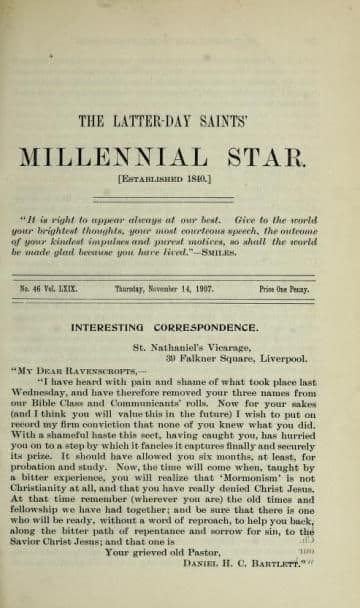Magazine
New Proof That the Bible Is True

Title
New Proof That the Bible Is True
Magazine
The Latter Day Saints' Millennial Star
Publication Type
Magazine Article
Year of Publication
1907
Editors
Penrose, Charles W. (Secondary)
Number of Pages
724
Date Published
14 November 1907
Volume
69
Issue Number
46
Abstract
This article discusses archaeological findings thought to confirm the Bible.
NEW PROOF THAT THE BIBLE IS TRUE.
Of the many excavations of ancient cities in Palestine confirming the accuracy of the Scriptural narratives, none has brought to light more interesting discoveries than that of the city of Gezer, so often mentioned in the Old Testament. This ancient Canaanitish city, it was claimed, was founded more than live thousand years ago.
It was the inhabitants of Gezer whom, according to Joshua 16:10, the children of Ephraim “drove not out,” but allowed still to dwell among them and serve under tribute. The old city, it is recorded, was rebuilt by Solomon.
That it was, in its day, a place of considerable strategic importance is shown by the strong outer walls recently unearthed. A portion of one of these walls reveals what is supposed to have been the lower part of a gateway. The stones surrounding the gateway were finely dressed, a fact which led to the conjecture that the work was done in the time of Solomon—a conjecture which strengthens the theory that this is indeed the city which Solomon rebuilt. (I. Kings 9:17.)
Near the supposed gateway is another wall of rougher masonry, which the excavators assume to be a portion of the Maccabean defenses.
The palace of Simon Maccabee has been uncovered, the unearthed Walls indicating the spaciousness of the apartments of the old Jewish patriot. An important feature of the house is an enormous stone bath with a furnace for heating the water and a system of pipes for carrying away the waste water.
Other houses of less pretentions, but of greater age, have also been uncovered. The walls of these latter houses consist of rough stones set in mud, a style of architecture supposed to have succeeded that of the prehistoric eave dweller. “High places”—places of worship and sacrifice—have been brought to light. It was in “high places” that the wooden “asherah” (an object of worship called “grove” in the English Bible) was erected.
Underneath the pavement of one of these “high places” there were found the remains of infants in large jars, the infants undoubtedly having been sacrifices to the “asherah.” Close by there were a number of sockets in which the “asherah” were erected. It was these sockets that the Israelites were commanded to destroy upon their invasion of the land.
Still another discovery was a circular pit in which were found a number of brazen serpents like a cobra. The pit, no doubt, contained sacred snakes.
This exploration, which is revealing so much that is valuable to the historian and the scientist, is being conducted by the Palestine Exploration Fund of England, of which Sir Charles Watson is chairman.—Leslie’s Weekly.
Subject Keywords
Bibliographic Citation
Terms of use
Items in the BMC Archive are made publicly available for non-commercial, private use. Inclusion within the BMC Archive does not imply endorsement. Items do not represent the official views of The Church of Jesus Christ of Latter-day Saints or of Book of Mormon Central.